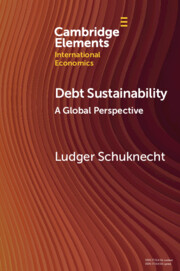53 results

Debt Sustainability
- A Global Perspective
-
- Published online:
- 31 August 2022
- Print publication:
- 15 September 2022
-
- Element
- Export citation
Dedication
-
- Book:
- Public Spending and the Role of the State
- Published online:
- 30 October 2020
- Print publication:
- 12 November 2020, pp v-vi
-
- Chapter
- Export citation
2 - The Composition of Expenditure
- from Part I - The Growth of Government
-
- Book:
- Public Spending and the Role of the State
- Published online:
- 30 October 2020
- Print publication:
- 12 November 2020, pp 36-59
-
- Chapter
- Export citation
Part III - Fiscal Risks
-
- Book:
- Public Spending and the Role of the State
- Published online:
- 30 October 2020
- Print publication:
- 12 November 2020, pp 153-232
-
- Chapter
- Export citation
7 - Social Expenditure and the Risk of ‘Social Dominance’
- from Part III - Fiscal Risks
-
- Book:
- Public Spending and the Role of the State
- Published online:
- 30 October 2020
- Print publication:
- 12 November 2020, pp 155-178
-
- Chapter
- Export citation
5 - Reforming Public Expenditure
- from Part II - Value for Money
-
- Book:
- Public Spending and the Role of the State
- Published online:
- 30 October 2020
- Print publication:
- 12 November 2020, pp 104-131
-
- Chapter
- Export citation
Index
-
- Book:
- Public Spending and the Role of the State
- Published online:
- 30 October 2020
- Print publication:
- 12 November 2020, pp 281-284
-
- Chapter
- Export citation
11 - Conclusions and Epilogue
- from Part IV - Remedies
-
- Book:
- Public Spending and the Role of the State
- Published online:
- 30 October 2020
- Print publication:
- 12 November 2020, pp 257-264
-
- Chapter
- Export citation
Acronyms and Abbreviations
-
- Book:
- Public Spending and the Role of the State
- Published online:
- 30 October 2020
- Print publication:
- 12 November 2020, pp xix-xx
-
- Chapter
- Export citation
3 - Financing Government
- from Part I - The Growth of Government
-
- Book:
- Public Spending and the Role of the State
- Published online:
- 30 October 2020
- Print publication:
- 12 November 2020, pp 60-78
-
- Chapter
- Export citation
Acknowledgements
-
- Book:
- Public Spending and the Role of the State
- Published online:
- 30 October 2020
- Print publication:
- 12 November 2020, pp xvii-xviii
-
- Chapter
- Export citation
Tables
-
- Book:
- Public Spending and the Role of the State
- Published online:
- 30 October 2020
- Print publication:
- 12 November 2020, pp xiii-xiv
-
- Chapter
- Export citation
Introduction
-
- Book:
- Public Spending and the Role of the State
- Published online:
- 30 October 2020
- Print publication:
- 12 November 2020, pp 1-14
-
- Chapter
- Export citation
Copyright page
-
- Book:
- Public Spending and the Role of the State
- Published online:
- 30 October 2020
- Print publication:
- 12 November 2020, pp iv-iv
-
- Chapter
- Export citation
Contents
-
- Book:
- Public Spending and the Role of the State
- Published online:
- 30 October 2020
- Print publication:
- 12 November 2020, pp vii-viii
-
- Chapter
- Export citation
Figures
-
- Book:
- Public Spending and the Role of the State
- Published online:
- 30 October 2020
- Print publication:
- 12 November 2020, pp ix-xii
-
- Chapter
- Export citation
9 - Fiscal–Financial Risks 2
- from Part III - Fiscal Risks
-
- Book:
- Public Spending and the Role of the State
- Published online:
- 30 October 2020
- Print publication:
- 12 November 2020, pp 204-232
-
- Chapter
- Export citation
Part I - The Growth of Government
-
- Book:
- Public Spending and the Role of the State
- Published online:
- 30 October 2020
- Print publication:
- 12 November 2020, pp 15-78
-
- Chapter
- Export citation
Preface
-
- Book:
- Public Spending and the Role of the State
- Published online:
- 30 October 2020
- Print publication:
- 12 November 2020, pp xv-xvi
-
- Chapter
- Export citation
1 - The Growth of Government Expenditure over the Past 150 Years
- from Part I - The Growth of Government
-
- Book:
- Public Spending and the Role of the State
- Published online:
- 30 October 2020
- Print publication:
- 12 November 2020, pp 17-35
-
- Chapter
- Export citation

